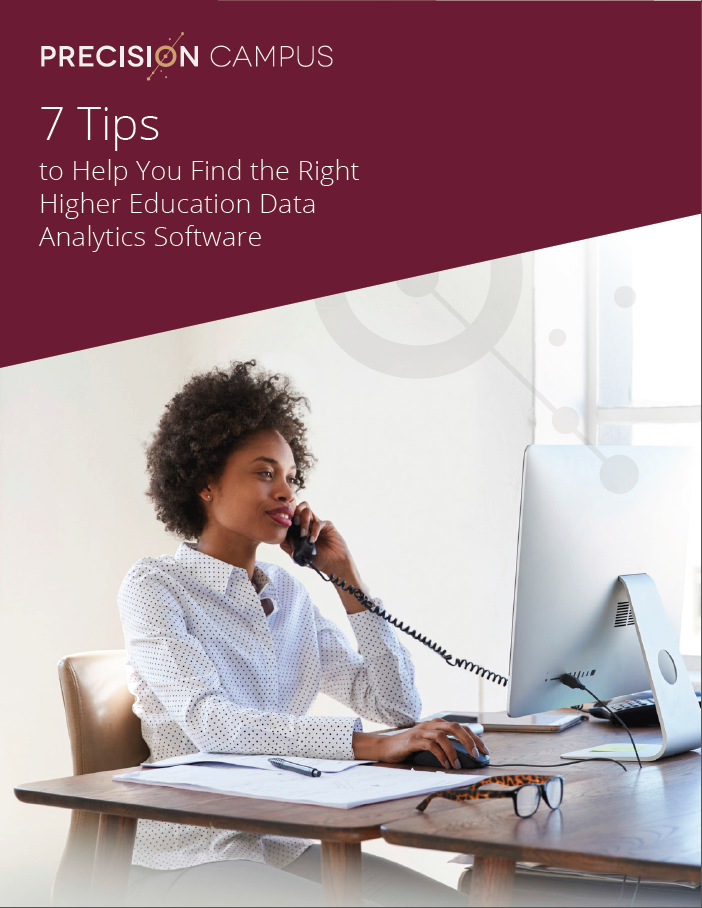No matter the industry, making data part of a culture is a process. It can be especially challenging if your organization is widely dispersed or not adaptive to new technology — such as the higher education industry.
Below, we’ve outlined what you need to know about data-driven decision making in education as well as five tips to help you implement a successful process.
10 Benefits of a Data-Driven Culture
10 Ways Colleges Can Leverage Their Data
5 Ways to Implement a Data-Driven Culture
What is Data-Driven Decision Making?
In a data-driven culture, decisions are made based on factual, verifiable information. The process typically includes analyzing data sets — including big data — to identify trends and make projections for the future.
An example of data-driven decision making in higher education could involve analyzing enrollment trends for a particular department. If you find that enrollments have been on a steady decline for sociology courses, a data-driven decision would be to re-evaluate the curriculum and merge or eliminate certain classes.
10 Benefits of a Data-Driven Culture
Data-driven decision making is used in nearly every industry, with higher education being just one of the latest to adopt it into their culture. Here are the major benefits:
1. Break Down Silos
Silos across an institution are far too common. The math department likely doesn’t communicate with the French department very often, but there’s a good chance they could both be facing similar challenges that can be revealed by data. When you break down these silos, it becomes easier for disparate departments to work together toward a common goal: student success.
2. Speak One Common Language
Institutions are complex, with various subcultures that need to communicate effectively. With a data-driven culture, you will all be speaking the same language. Instead of intuition-based decision-making, the focus turns to vital metrics and KPIs, which will ensure everyone is on the same page.
3. Validate Your Instincts
Let’s say your Algebra I course has a very low success rate. More students fail than pass, and they are unlikely to succeed in other math classes taken after Algebra I.
Your intuition may tell you that this is because the course is too difficult. However, your data might show that the students enrolling in this course are not properly prepared. They may have struggled with math in high school or are in need of a little bit of extra support. From here, you can re-evaluate the enrollment requirements and implement more support services to help these students succeed.
4. Establish Consistency
A data-driven culture requires consistency. Evaluating course success rates and year-over-year enrollment numbers is never a “one and done” deal — it takes time to create benchmarks and truly understand what the numbers are telling you. Since your data-driven culture will require routine attention, you will be able to establish a more consistent process.
5. Allow Everyone More Access to Data
Data is digital, which means there’s no lock and key required to parse through the file cabinets in the admissions office. If the English department needs to look at the year-over-year enrollments for their literature courses, anyone with access to the data program can log on and find exactly what they need.
6. Faster Decision-Making Processes
Storing all of your institution’s information in a centralized location is a time-saver. Once your school has adopted the practice, you will spend less time combing through endless data sources and more time putting the information to work for you.
7. Establish Predictive Practices
Using your historical data, you can make predictions on what’s to come in the future. If the history department has seen declining enrollments for their European history course steadily for the past four semesters, you may be able to predict a continuous lull and make moves to find a solution.
8. Create a Public Fact Book
Prospective students will want to know their chance for success at your institution before they take the time to apply. With your data sets, you can create a public fact book on your website that backs up your claims with factual numbers. Students will be interested in seeing your class sizes, student-to-teacher ratio and success outcomes.
9. Prioritize Student Success
Retaining students is cost-effective for any institution, but the focus on student success can get lost in the grand scheme of operations. With data on your side, the numbers and statistics will be continuous reminders of what your goals are, whether that’s increasing enrollments, boosting retention rates or improving student success metrics.
10. Streamline Processes & Productivity
The antiquated processes of spreadsheets and file folders is time-consuming and often inefficient. Requesting reports from the institutional research department can take days or even weeks, and it’s even harder to get a sense of your statistics in real time.
But with a data-driven culture, you will have modern, interactive tools that are designed for efficiency. The institutional researchers can spend their time working on big-picture projects, while you assess the reports you need whenever and wherever you need them.
10 Ways Colleges Can Leverage This Data
Since colleges and universities have more data now than ever before, the higher education industry can embrace a data-driven culture to:
1. Supplement Intuition with Historical Trends & Projections
One of the biggest benefits for higher education is that it allows educators to make decisions based on historical trends and projections for the future. Brainstorming sessions can be supplemented with reports that display patterns and trends, as opposed to strategizing ideas based on speculations or assumptions.
2. Gauge the Success of Your Efforts
Data then allows you to measure the success of your efforts. If you used past trends to strategize how to cut costs in the engineering program, you can compare your projections to the actual outcome and determine the effectiveness of your decisions.
3. Identify & Improve Student Outcomes
Institutions have recently started to place more emphasis on using data to track and improve student outcomes.
“Shifting to the awareness and improvement of student outcomes is fairly new to education,” said Bob Barr, retired institutional researcher currently consulting with Gavilan College. “But while data and analytics for outcomes are not yet well advanced in many institutions, a tool like Precision Campus can help a lot.”
4. Intervene with At-Risk Students
The data profiles for every student will include details like if they are a first-generation student, their high school grades and GPA and their performance in their current courses.
If your historic data has shown that first-generation students struggle in certain classes or programs, advisors can make efforts to provide additional support to increase the odds of retention and success.
5. Understand Student Retention & Success Rates
Speaking of retention and success, it’s far more cost-effective to retain current students than to recruit new ones. What does your data say about these rates? Is retention low for a certain cohort? Are success rates dropping for a certain program? Your data will show you the answers to these common questions.
6. Improve Marketing & Recruitment Strategies
Where are your first-year students coming from? Do they share a common, local zip code or are they enrolling from out of state? Did they engage with any recruitment marketing efforts before applying?
When you have answers to these questions, you can better target you marketing efforts and potentially increase the success of your recruitment strategies.
7. Evaluate & Enhance Curriculum
Do courses with high dropout rates have anything in common? Maybe they’re held during rush hour and are full of commuter students. Or maybe they all share the same instructor. Look at your data to find commonalities. Then you can revise your goals and create plans for improvement
8. Gauge Instructor Productivity
What about your faculty? Their productivity levels are just as important as student success rates, and courses with declining enrollments will affect your entire institution’s success. You can also use data to evaluate if replacing part-time faculty with full-time instructors would be more cost-efficient.
9. Track Resource Allocation
One class requires a lot of resources. There’s the actual room itself, the utilities like lighting and heat and then the professor to instruct the students. Optimizing your resources any way you can will make your operations more efficient and can open up opportunities for reassessment.
Adopting a data-driven culture is an adjustment that will likely take time to become successful. You can use the tips below to ensure that you’re off to the best start possible.
10. Connect Your Digital Channels
Your institution can collect data from your social media accounts, email marketing campaigns, websites, mobile apps and any other digital avenue available. While this data may not directly apply to things like student success, it will tell you how people are engaging with your brand on the web.
5 Ways to Implement a Data Driven Culture
1. Lead by Example
First, your institution’s leadership needs to embrace data in order for the rest of your employees to get on board. Once stakeholders are invested, you should be as transparent as possible with the rest of your team, so they know why there is a change.
Your team will likely be curious to know:
- Your reason for embracing data
- A timeframe for implementation
- How their jobs may be affected
- Where they can turn for help
You should also check in regularly with everyone who is utilizing the new process to identify what’s working and what’s not. This will give everyone a chance to be heard during the adjustment period and will give you an idea of areas that you may still need to improve.
2. Establish Goals
What are you hoping to achieve?
In a data-driven culture, you’ll have a lot of information available at your fingertips — so much information that it could become chaotic if you don’t set specific goals.
Before diving into your data, you need to have a strategy in place. You’ll have data sets for everything that goes on in your institution — faculty productivity, student success rates, resource allocation, etc. — so it’s important to determine which are most relevant to your goals.
Start by figuring out exactly what you’re hoping for. Do you want to increase enrollments in English classes by 5% in the next two years? If so, you won’t need to bother with fundraising data or enrollment numbers for the science department. Keeping goals like this in mind will make it easier to prioritize your information.
Maybe you just want everyone in your institution to utilize data independently so that your institutional research department isn’t bogged down by creating simple reports. If big goals — like a substantial increase in enrollments — seem out of reach, try working toward small milestones like this instead.
3. Set Expectations
Implementing a data-driven culture will require some of your employees to understand and follow a new process. It might take time for everyone to adjust, but setting expectations through open communication can help make the transition seamless.
You can start small in order to get everyone acclimated. Maybe one department will roll out a data-driven process to test the waters and then offer feedback before your entire institution implements it.
It will also be beneficial to create a schedule for analyzing and reporting on your data that aligns with the times you need it the most for planning and strategizing. Are there certain times of the year when you reassess your course offerings? Preparing your data well beforehand will give you time to digest the numbers so you can make the best data-driven decisions possible.
4. Make Data Easy to Understand
In a data-driven culture, information needs to be easy to access and simple to understand. Otherwise, it will be difficult for everyone to fully get on board with the transition.
Think about it: An endless spreadsheet full of numbers will do nothing except cause headaches for whoever is tasked with managing and interpreting the information.
For full transparency, you should make sure that employees are able to access data exactly when and where they need it. And once they get it, the information needs to be organized and presented properly to avoid time-consuming, confusing processes.
If no one is able to actually understand your data, the purpose of it will quickly be defeated.
5. Use a Data Analytics Program
The amount of data you have will require a robust infrastructure. However, a data analytics platform will make it incredibly easy to manage, organize and analyze your institutional data sets.
Software solutions make data incredibly easy for anyone with credentials to access, so your research department can avoid becoming overwhelmed by requests. Modern data analytics platforms can also convert dull numbers into visual pie charts, bar graphs and line graphs, so your data can be much easier to interpret and utilize.
Frequently Asked Questions
Q: What is data-driven decision-making?
A: This is the practice of using historical numbers and statistics to support your strategies all around campus. The goal is to have hard facts that back up your decisions, as opposed to flying blind on intuition.
Q: What resources are necessary for a data-driven culture?
A: First of all: data! But of course, this data will need to live somewhere. An automated data analytics platform is a must-have. These platforms are designed to make it easy to understand the numbers on the screen. A static spreadsheet may work in some instances, but you will get the most value from a modern web-based system.
Q: How long does it take to create a data-driven culture?
A: It will take time for this practice to become fully adapted. There may be reluctance at first, but this is normal. To ensure that your data-driven cultures starts off on the right foot, it’s important to clearly communicate the reasons and goals for the change to everyone who will be involved or affected.
–
Precision Campus is a data analytics software platform designed exclusively for higher education. We make it easy for institutions to store, manage and analyze data in order to establish a data-driven decision-making culture.
The best part? You can get started with Precision Campus for free!



